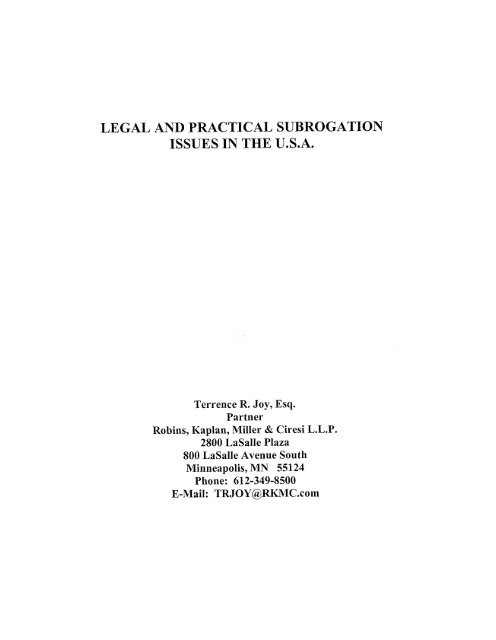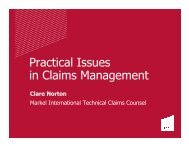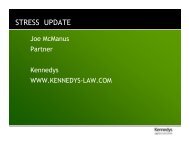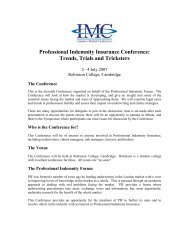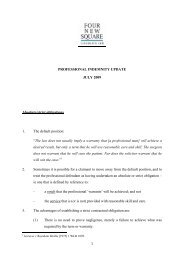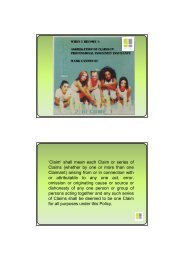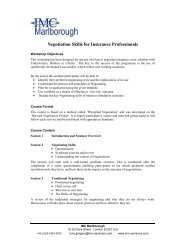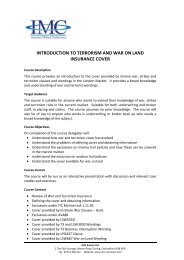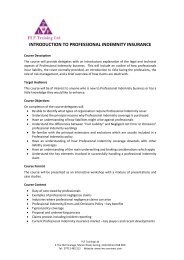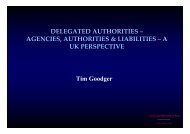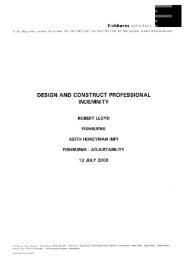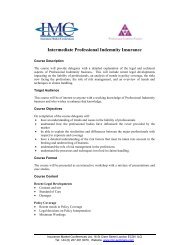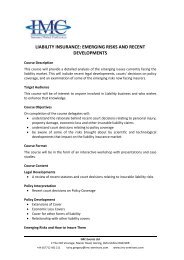LEGAL AND PRACTICAL SUBROGATION ISSUES IN THE U.S.A.
LEGAL AND PRACTICAL SUBROGATION ISSUES IN THE U.S.A.
LEGAL AND PRACTICAL SUBROGATION ISSUES IN THE U.S.A.
You also want an ePaper? Increase the reach of your titles
YUMPU automatically turns print PDFs into web optimized ePapers that Google loves.
<strong>LEGAL</strong> <strong>AND</strong> <strong>PRACTICAL</strong> <strong>SUBROGATION</strong><strong>ISSUES</strong> <strong>IN</strong> <strong>THE</strong> U.S.A.Terrence R. Joy, Esq.PartnerRobins, Kaplan, Miller & Ciresi L.L.P.2800 LaSalle Plaza800 LaSalle Avenue SouthMinneapolis, MN 55124Phone: 612-349-8500E-Mail: TRJOY@RIUMC.com
TABLE OF CONTENTSPageIntroduction ................................................................... 1Doctrines Limiting The Right Of Subrogated Carriers .................. 11. Economic Loss Limitations .................................. 12. Home Insurance Company v. Pinski Limitation ........... 5Recoveries Against Co-Insureds ............................................ 10Proration Of Recoveries - “First Dollar Out” Doctrine.. ................ 12Subrogation Waiver Issues .................................................. 15Foreign Nationals’ Access To Courts In The United States .............The Impact Of Tort Reform On Subrogation Claims .....................1619
<strong>LEGAL</strong> <strong>AND</strong> <strong>PRACTICAL</strong> <strong>SUBROGATION</strong><strong>ISSUES</strong> <strong>IN</strong> <strong>THE</strong> U.S.A.<strong>IN</strong>TRODUCTIONThis paper deals with subrogation in the United States and its legal and practicalimplications. While the paper does not exhaust all potential issues, it does focus on themore recurrent scenarios and problems.Subrogation in the United States is a doctrine of equitable origin which allows aninsurer who has indemnified its insured to stand in his shoes and acquire rights against athird party. While standing in the shoes of the insured, the insurer acquires all of therights and entitlements, as well as all of the limitations and obligations. Therefore, therelationship between the insured and the third party tortfeasor is of paramount concernsince that relationship will determine the rights and responsibilities of the subrogatedinsurer.DOCTR<strong>IN</strong>ES LIMIT<strong>IN</strong>G <strong>THE</strong> RIGHT OF SUBROGATED <strong>IN</strong>SURERS1. Economic Loss LimitationOne of the more misunderstood and misapplied doctrines in theUnited States is the Economic Loss Rule. The Economic Loss Rule precludes recoveryin tort when a product defect causes only economic losses and does not result in personalinjury or damage to property other than the product itself. The type of economic lossesthat cannot be recovered in tort are the diminution in the value of the product and loss ofMP3 20204330.1
use. As such, economic loss embrace damages for inadequate value, costs to repair andconsequential damages, including loss of profits.In a traditional subrogation claim, the insurer normally pays for property damageto the product itself if one is involved and the business interruption resulting from thatdamage. If the jurisdiction in which the event occurs has adopted the Economic LossRule, the insurer's ability to recover these damages may be severely curtailed.East River Steamship Corp. v. Transamerica Delaval' is one of the leading casesdiscussing the Economic Loss Rule and while it only applies in federal courts, a numberof state courts follow it. In East River, the defendant designed and manufactured fourturbines which were installed on separate super tankers. While the tankers were undercharter to the plaintiff, the turbines failed damaging themselves and producing asubstantial loss of income. The plaintiff brought an action against the manufacturerseeking to recover the cost of the damage to the turbines as well as the lost income. TheUnited States Supreme Court framed the issue as follows: Is there a cause of action whena defective product purchased in a commercial tr~ansaction maZfunctions injuring oizly theproduct itself and causing purely economic loss?In analyzing the issue, the court considered the minority view2 which would allowthe plaintiff to recover all of its damages and the majority view3 which would preclude123476 U.S. 858 (1986).Santor v. AMKaragheusian Inc., 44 N.J. 52,207 A.2d 305 (1965).Seely v. White Motor Co., 63 Cal.2d 9,403 P.2d 145 (1965).MP3 20204330.1-2-
tort liability when a defective product causes purely monetary damage. In adopting themajority view, the court observed:“The tort concern with safety is reduced when an injury isonly to the product itself. When a person is injured, the costof an injury on the loss of time or health may be anoverwhelming misfortune, and one the person is not preparedto meet. In contract, when a product injures itself, thecommercial user stands to lose the value of the product, risksthe displeasure of its customers who find that the productdoes not meet their needs or, as in this case, experiencesincreased costs in performing a service. Losses like these canbe insured. Society need not presume the customer needsspecial protection. The increased cost to the public thatwould result from holding a manufacturer liable in tort forinjury to the product itself is not justified.”Tlius, the court concluded that a manufacturer in a commercial relationship had no dutyunder a negligence or products liability theory to prevent a product from injuring itselfand thus none of the damages were recoverable. Since East River, the Economic LossRule has been followed in some jurisdictions, ignored in others, and codified in at leasttwo. Today it is safe to say that most jurisdictions adhere to the East River rationale insome fashion.As a consequence, an insurer’s subrogation recoveries have beendramatically affected.Some jurisdictions have tried to ameliorate the harshness of the rule by creatingexceptions. For example, in some states if the product damages other property, then thedoctrine may not apply.4 These courts feel that the purchaser did not bargain for thistype of risk. Other jurisdictions examine the nature of the incident causing the damage4M1’3 20204330.1Moorman Mfg. Co. v. National Tank Co., 91 I11.2d 69,435 N.E.2d 443 (1982).-3-
and if it can be characterized as catastrophic, the rule will not apply.' For example, if theproduct explodes or fails in a violent or sudden fashion, some courts will not apply therule because the product has created a situation which is potentiaZZy dangerous to personsor other property.While the Economic Loss Rule should only concern products and consumerexpectations, a number of courts have applied it in situations where it does not belong.For example, in one case the court used the rule to bar the claims of tenants who wereforced from their high rise offices when a contractor negligently flooded the basementsof buildings they occupied.' Another court applied the rule when telephone service wasnegligently interrupted to customers in a major metropolitan area.7 Neither case dealtwith the sale of a product or with consumer expectations, but in both cases the courts saidplaintiffs could not recover damages because they were economic losses.While the courts said that they were applying the Economic Loss Rule to thesesituations, the cases really concern the doctrines of proximate cause, foreseeability, andduty. In Madison Avenue Gourmet Foods v. Fiizlandia Center,' the court recognized thedistinction and while barring recovery to a plaintiff who sustained no property damage,did not use the rubric of economic loss. In this case, access to the plaintiffs delicatessenwas blocked when a construction project collapsed on Madison Avenue in New YorkCity. The plaintiff had no property damage and his only loss was for income. In denying5678MP3 20204330.1Bailey Farms Inc. v. Nor-Am. Chemical Company, 27 F.3d 188 (6th Cir. 1994).In Re Chicago Flood, 176 I11.2d 179,680 N.E.2d 265 (1997).In Re Illinois Bell Switching Station, 161 111.2d 233,641 N.E.2d 440 (1994).96 N.Y.2d 280,750 N.E.2d 1097 (2001).-4-
ecovery, the court said that the economic loss rule had no application because that ruledealt with end purchasers of products who were making claims against manufacturers.The court said that the problem needed to be analyzed in the context of defendant’s dutyto plaintiff. In this situation, the court said that a landowner owes a duty to adjoiningproperty owners, but he owes no duty to protect an entire urban neighborhood fromeconomic losses.The Economic Loss Rule is a major limitation on a subrogating insurer’s rights.Since the insurer normally pays for damage to the property as well as for damage fromthe loss of use of that property, it will be unable to recover these economic losses if thejurisdiction is applying the majority rule. On the other hand, if the jurisdiction recognizesthat damage to other property is an exception or looks to the nature of the event, then theinsurer may recover. Unfortunately, a subrogated insurer in one state may find itselfbarred while a subrogated insurer in a state across the border might recover on the samefacts. Such, however, are the vagaries of the judicial system in the United States.2. Home Insurance Compaizv v. Pinski LimitationHome Insurance Company v. Pinski’ dealt with a seemingly straightforwardproposition of law - an insurer cannot subrogate against its own insured. However, thecommon understanding of this rule is that it is applied only to an insured named in thepolicy. Pinski, on the other hand, deals with a very different situation. In Pinski, theHome Indemnity Company paid a property damage loss caused by an explosion at the9MP3 20204330.1160 Mont. 219,500 P.2d 945 (1972).-5-
insured’s building. Home Indemnity then brought a subrogation action against severaldefendants, including an architectural firm who had a liability insurance policy with theHome Insurance Company. The court assumed that the Home Insurance Company andthe Home Indemnity Company were one and the same.The issue was whether the Home Indemnity Company could maintain asubrogation action against a third party who it also insured under a separate and unrelatedliability policy. The Montana Supreme Court refused to allow the action to proceed anddismissed the Complaint. In reaching its decision, the court said:“To permit the insurer to sue its own insured for a liabilitycovered by the insurance policy would violate these basicequity principles, as well as violate sound public policy.Such action, if permitted, would (1) allow the insurer toexpend premiums collected from its insured to secure ajudgment against the same insured on a risk insured against;(2) give judicial sanction to the breach of the insurance policyby the insurer; (3) permit the insurer to secure informationfrom its insured under the guise of policy provisions availablefor later use in the insurer’s subrogation action against itsown insured; (4) allow the insurer to take advantage of itsconduct and conflict of interest with its insured; and (5)constitute judicial approval of a breach of the insurer’srelationship with its own insured.. . . To allow subrogation under such circumstances wouldpermit an insurer, in effect, to pass the incidents of the loss,either partially or totally, from itself to its own insured andthus avoid the coverage which its insured purchased.”MP3 20204330.1-6-
The Pinski principle has been followed in several jurisdictions in the United States, buthas also been rejected in at least four others.” Furthermore, some courts will not followthe doctrine if the subrogated insurer and the liability insurer are merely related asaffiliated or “sister” companies. Fashion Tanning Co., Inc. v. Fulton Cty. ElectricalCorztrs., Inc. ’IApplication of the Pinski doctrine to a complex subrogation case can havesubstantial ramifications. For example, in a shared or layered insurance program, allsubrogated insurers who also insure a potential defendant must drop claims against thatdefendant. While the action can proceed some subrogated insurers may conclude that itis not worth pursuing the claim if the remaining defendants are marginally at fault orimpecunious.There has been at least one significant exception to Pinski where a court allowedan insurer to subrogate against a defendant that it also insured under a separate liabilitypolicy. In Transport Trailer Service, Inc. v. Upjohn Co. 12,the insured had a fire loss andloNorris v. Allstate Ins. Co. (La. App. 1974), 293 So.2d 918; Cozzi v. Government Einp.Ins. Co. (N.J. App. 1977), 154 N.J. Super. 519; Transport Trailer Sew., Inc. v. The Upjohiz Co.(E.D. Pa. 198l), 506 F. Supp. 442; Fashion Tanning Co., Inc. v. Fulton Cty. Electrical Contrs.,Inc. (1989), 142 A.D.2d 465,536 N.Y.S.2d 866.142 A.D.2d 645, 536 N.Y.S.2d 866 (1989). For a contrary result, see Royal ExchangeAssurance of America v. SS President Adams, 581 (W.D. Wash. 1981) where the court said thattwo separate insurance companies that shared the same telephone, mailing address,administrative offices and directors were one and the same. In Keystone Paper Converters v.Philadelplzia Electric Co., 562 F. Supp. 1046 (E.D. Penn. 1983), the court refused to allowsubrogation saying “I have grave doubts that the federal courts should be used by an insurer toclean up its books, and if need be, transfer funds from its liability pool to its indemnity pool.”I2MP3 20204330.1506 F. Supp. 442 (E.D. Pa. 1981).-7-
eceived $191,000 from its property insurer. The insured then brought an action onbehalf of itself and its insurer claiming that defendant’s polyurethane foam wasresponsible for spreading the fire. The defendant was also insured by the plaintiffsinsurer under a separate liability policy; however, that policy had a $5,000,000 self-insured retention. The defendant moved to dismiss the action arguing that the PiizsJzidoctrine precluded the insurer from suing its own insured.The court disagreed and said that in this situation Pinski would not apply. Inreaching its conclusion, the court said:“Upjohn has paid Aetna a premium for a products liabilitypolicy calculated on a deductible in the amount of$5,000,000, and its incurred losses for the relevant policyyear do not yet total that sum. To preclude any subrogationclaim by Aetna on behalf of any other company also insuredby Aetna which may have a valid claim against Upjohn whenthis deductible amount has not yet been exhausted mightallow Upjohn an un-bargained for, unpaid for, windfall; a risknot otherwise insured against would in effect be covered byUpjohn’s insurance policy with Aetna because of a fortuitousfact, i.e. that liability was asserted against Upjohn by a party,Transport, which also happens to be insured by Aetna. Aninsurance company might hesitate to pay promptly claims ofone insured if it could never assert a subrogation claimagainst any other insured. As a general rule, this seems anundesirable reallocation of risk.”Thus, in those instances when a defendant has a substantial self-insured retention in itsliability policy, subrogation may not be barred.In deciding whether to apply the Pinski rule, the courts will not condone tactics orpractices which demonstrate an element of bad faith to avoid the effect of Pinski. ForMP3 20204330.1-8-
example, in Keystone Paper Converters v. Neemar, Inc., l3 the subrogated insurer broughtan action against a defendant that it also insured under a separate liability policy. Ratherthan move to dismiss the action, the defendant joined two third-party defendants seekingindemnification from them. It appeared that counsel for the plaintiff and counsel for thedefendant had “scripted” this scenario to pass the liability through to the third partydefendants. The third party defendants sought dismissal of the third-party claims on thebasis that the primary subrogation claim was barred under the Pinski principle. The courtagreed and held that the defendant insured’s interests were in jeopardy even if it waspossible to pass the losses on to the third-party defendants. In the court’s view, thedefendant could end up with a judgment against it which might increase its insurancepremiums, make it a less insurable entity, or affect its credit rating. The lesson ofKeystone Paper is that courts will not condone collusive efforts to avoid the effects ofPinski.When an insurer finds itself on both sides of a subrogation action, subrogationmay be barred. One might ask why a subrogated insurer would pursue subrogationagainst an entity it was obligated to indemnify since it would seem to be taking moneyfrom one pocket and putting it in the other. However, consider the situation where thesubrogated insurer has a substantial claim against an entity it also insures, but that entityhas a low limit of primary liability and substantial excess coverage with a differentinsurer. In that situation, it would seem to be in the subrogated insurer’s interest tol3MP3 20204330.1562 F. Supp. 1046 (E.D. Pa. 1983).-9-
proceed with the action in an effort to reach the excess limits; however, even in thatsituation at least one court has said that subrogation is not permitted. National UnionFire Insurance Company v. Engineering-Science, Inc.14RlECOVERIES AGA<strong>IN</strong>ST CO-<strong>IN</strong>SUREDSIn spite of Pinski, some courts have considered and allowed subrogation againstcoinsureds in the builders risk context. For example, in Paul Tishman Company v.Carney & Dell Guidice, Inc.,” the court said that a builder’s risk policy is propertyinsurance and not liability insurance and thus the policy covers only property in which anamed insured has an insurable interest. Accordingly, a builder’s risk policy does notinsure a named insured subcontractor for its potential legal liability to a generalcontractor. Therefore, a subrogee can proceed against a subcontractor for any damage toproperty in which the subcontractor does not have an insurable interest.A contrary view known as the Louisiana Rule’‘ holds that an insurer cannot pay ageneral contractor for its losses and then seek to recover from a subcontractor who isnamed as an additional insured on the policy. In these cases, the courts interpret thepolicy language “as their interests may appear” to encompass liability, as well as propertyinterests. Cases adopting the Louisiana rule say that there is a conflict of interest whenan insurer is permitted to sue an insured who is under a duty to cooperate with theinsurer. Other courts rely on public policy considerations to preclude subrogation. Those141516MP3 20204330.1673 F. Supp. 380 (N.D. Cal. 1987).320 N.Y. Supp.2d 396.Glens FuIls Ins. Co. v. Globe Indemnity Co., 214 La. 467, 38 S.2d 139 (1948).- 10-
considerations include reduction of litigation and the financial burden which would beplaced on subcontractors to protect themselves from potentially devastating litigation.Beyond the builders risk context, there are other situations in which courts haveconcluded that subrogation against a co-insured will not be permitted.These casesusually involve a landlord’s insurer subrogating against a tenant who caused damage tothe leasehold. In many jurisdictions, the courts have concluded that absent an expressagreement in the lease establishing liability, a tenant is an implied co-insured on thepolicy. As such, the landlord’s insurer will not be allowed to pursue subrogation againsta negligent tenant. Courts following this approach have said that a landlord who obtainsinsurance for the property in effect passes through the cost of the premiums to the tenantin the form of rent, thus making the tenant an implied coinsured.” While this is a legalfiction, it has substantially impacted an insurer’s ability to subrogate against a negligenttenant.In summary, tenants and subcontractors are immune from subrogation claims inmany jurisdictions. Whether the courts use the language of the policy, the language ofcontractual provisions, or the applications of common law, the trend is to limit the right17Sutton v. Jondahl, 532 P.2d 478 (Okla. 1975); Alaska Ins. Co. v. RCA AlaskaCommunications, Inc., 623 P.2d 1216 (Alaska 1981); Liberty Mutual Fire Ins. Co. v. Auto SpringSupply Co., 59 Cal. App.3d 860, 131 Cal. Rptr. 211 (1976); Safeco Ins. Co. v. Weisgerber, 115Idaho 428, 767 P.2d 271 (1989); Reeder v. Reeder, 217 Neb. 120, 348 N.W.2d 832 (1984);Safeco Ins. Co. v. Capri, 101 Nev. 429, 705 P.2d 659 (1985); Fashion Place Invs. Ltd. v. SaltLake County Mental Health, 776 P.2d 941 (Utah App. 1989); Monterey Corp. v. Hart, 216 Va.843,224 S.E.2d 142 (1976); Cascade Trailer Court v. Beeson, 50 Wash. App. 678,749 P.2d 761(1988).- 11 -MP3 20204330.1
of subrogation. There are, of course, states which have protected the subrogated carriers’rights and if the loss occurs in one of those jurisdictions, subrogation can proceed.PRORATION OF RECOVERIES - “FIRST DOLLAR OUT” DOCTR<strong>IN</strong>EThe division of subrogation dollars between insured and insurer can be anextremely complex and divisive issue.For example, when an insured sustains asubstantial uninsured loss and then joins with the insurer in subrogating against thewrongdoer, how is any recovery shared? Should the insurer be made whole for all of itsindemnity payments before the insured makes any recovery? On the other hand, shouldthe uninsured loss, including any deductible, be satisfied before the insurer makes anyrecovery?Professor Robert Keaton, a recognized authority on insurance law, has categorizedthe various approaches to apportionment of subrogation recoveries as follows:Rule 1 (Insurer: Whole Plus):Rule 2 (Insurer: Whole):Rule 3 (Proration):Rule 4 (Insured: Whole):Under this rule, the insurer is the sole beneficialowner of the claim and is entitled to fullrecovery even if it exceeds the amount paid bythe insurer to the insured.Under this rule, the insurer is to be reimbursedfirst out of any recovery and the insured then isentitled to the difference remaining.Under this rule, the recovery is proratedbetween the insurer and the insured accordingto the percentage of the original loss for whichthe insurer paid the insured.Under this rule, the insured is reimbursed firstfrom any recovery and the insurer is entitled toMP3 20204330.1- 12-
any balance remaining after the insured is fullyreimbursed.Rule 5 (Insured: Whole Plus):Under this rule, the insured owns the entireclaim against the third party and is entitled toany amount recovered whether or not thisexceeds the insured’s loss.’*While all of the rules have their adherents, the majority of jurisdictions have adoptedeither Rule 2 or Rule 4.Rule 3 is typically only followed when the parties havecontractually agreed to proration.Those jurisdictions which adopt Rule 2 represent the minority view in the UnitedStates.By far, the greater weight of authority is that the insured must be fullycompensated for any uninsured loss before the insurer can share in the proceeds.Approximately 27 states have adopted the rule in some form or another.Garrity v. Rural Mutual Insurance C0.19 is one of the most frequently cited casessupporting the rule. In Garrity, the subrogated insurer had made payments under itspolicy of fire insurance. The insured commenced its own action against the tortfeasorsand eventually settled his claims for less than the actual amount of his damages. Theinsurer asked for a declaration that it was entitled to recover its payment before theinsured received any of the proceeds.The court denied the insurer’s request andconcluded that the insured must be completely compensated for all elements of damagesbefore the insurer’s subrogation rights arise. Thus, the insured was entitled to keep theentire amount of the settlement to the exclusion of the insurer.l9MP3 20204330.1Robert E. Keeton, Basic Text on Insurance Law 9 3.1 O(c)(2) (1 971).253 N.W.2d 512 (Wis. 1977).- 13 -
The Garrity rule is based on several rationales.Some courts believe thatsubrogation does not arise until the insured is made whole. Other courts theorize that ifthe question is whether the insurer or the insured must go unpaid, the insurer should bearthe loss for it has been paid to assume that risk. Whatever reason, the result is the same -the insured must be fully paid for all losses before the subrogated insurer acquires anyright of subrogation.One way to deal with this issue and create a level of certainty between insurer andinsured is to agree either before or after a loss to apportion recoveries. For instance,certain policies of insurance may contain the following provision:“The company may require from the insured an assignment ofall right of recovery against any party for loss to the extentthat payment therefore is made by the company, but thecompany shall not acquire any rights of recovery which theinsured has expressly waived prior to loss, nor such waiveraffect the insured’s rights under this policy.Any recovery as a result of subrogation proceedings arisingout of a loss occurrence, after expenses incurred in suchsubrogation proceeding are deducted, shall accrue to theinsured in the proportion that the deductible amount and/orany provable uninsured loss amount bears to the entireprovable loss amount.”Under this formula, both insurer and insured agree in advance to a proration mechanism.The only element which would require negotiation is to reach an agreement as to theamount of the insured’s “provable uninsured loss.”If the policy is silent on the issue, the parties can enter into a post loss prorationagreement. This can be a very useful method to resolve apportionment problems. NotMP3 20204330.1- 14-
only can recoveries be apportioned, but fees, costs and expenses can also be apportioned.A proration agreement eliminates the uncertainty and guess work between the insurer andthe insured and establishes with finality a method of allocating recoveries and expenses.<strong>SUBROGATION</strong> WAIVER <strong>ISSUES</strong>Many property insurance policies allow an insured to waive an insurer’s right ofsubrogation in advance of a loss. Since express waivers are common in contracts, leases,and purchase agreements, granting permission to waive without penalty became anecessary feature in property policies.All courts will enforce agreements to waivesubrogation and thus an insurer faced with an express waiver of subrogation would seemto have little chance of recovery.There is one situation in which an insurer may avoid the consequences of anexpress waiver of subrogation. In a majority of states, the courts have said that a partycannot exculpate himself from the consequences of gross negligence or willfiil andwanton conduct. Courts adhering to this view, adopt the Restatement of the Law 2d,Contracts, 5 195, which provides as follows:“Terni exempting from liability for harm caused intentionally,recklessly or negligently:(1) A temi exempting a party from tort liability for haincaused intentionally or recklessly is unenforceable ongrounds of public policy.MF3 20203330.1-15-
Most jurisdictions considering this issue have adhered to the principle that public policydoes not permit a party to exculpate himself from gross negligence.”However, applying the exception is only half the battle for the insurer. Not onlymust the exception be recognized in the jurisdiction where the claim is pending, but thefacts of the accident must amount to willful and wanton conduct or gross negligence.Gross negligence connotes an element of reckless indifference whereas willful andwanton conduct connotes deliberate or intentional actions. If the tortfeasor’ s conductrises to either level, that conduct will trump the subrogation waiver and the issue will beresolved by the jury.FOREIGN NATIONALS’ ACCESS TO COURTS <strong>IN</strong> <strong>THE</strong> UNITED STATESIt is not uncommon for a foreign national to seek redress in the courts of theUnited States for torts occurring in the United States. In such a situation, U.S. courtshave no difficulty in providing the foreign national with a forum to air his grievances.However, when foreign nationals seek redress in the United States for torts which tookplace outside the borders of this country, the courts take a more restrictive view. Courtsfaced with this type of situation often find that they are neither equipped to handle norinclined to give access to a foreign national.2oTravelers Indemnity Company v. The Losco Group, Inc., et al., 136 F. Supp.2d 253(2001); Tlzonzas v. Atlantic Coast Line R. Co., 201 F.2d 167 (1953); Donald Englehardt, et al. v.Triple X Chemical Laboratories, Inc., 53 111. App.3d 926, 369 N.E.2d 67 (1977); GoldConnection Discount Jewelers, Inc. v. American District Telegraph Company, Irzc. , 2 12 A.D.2d577, 622 N.Y.S.2d 740 (1995). For a contrary view, however, see St. Paul Fire and Marine Ins.Co. v. Universal Builders Supply, 409 F.3d 73 (2nd Cir. 2005) where the court said that allclaims including claims for gross negligence are barred as a matter of law by a waiver ofsubrogation clause in a written lease.- 16-MP3 20204330.1
What right do foreign nationals injured abroad have to use the courts of the UnitedStates to address their grievances? Why should someone who neither supports thegovernment nor pays for its upkeep be permitted to use the courts of the United States tofurther his own self interest? Fortunately, for foreign nationals, these xenophobic pleasdo not always find a receptive audience.In Ison v. E.I. Dupont de Nemows & Company,21 the plaintiffs were foreignfamilies whose claims arose out of birth defects caused by a chemical manufactured bythe defendant. The injuries occurred in England, Wales, Scotland and New Zealand as aresult of exposure to the chemical when used agriculturally.All of the plaintiffs were seeking relief against the defendant in a Delaware statecourt. The trial court had dismissed the case on the grounds offorum non convenienssaying that the plaintiffs had a remedy in their own country. On appeal, the DelawareSupreme Court reversed the trial court and said that the action by the foreign nationalscould proceed in Delaware even though the occurrences took place outside of the UnitedStates.The court said that the defendant would have to prove it would be anoverwhelming hardship if it had to defend the case in the United States. To satisfy thisstandard, the defendant would need to show that this “is one of the rare cases where thedrastic relief of dismissal is warranted based on a strong showing that the burden oflitigating in this forum is so severe as to result in manifest hardship to the defendant.”21MP3 20204330.1729 A.2d 832 (Del. 1999).- 17-
The Ison rule is not, of course, uniformly followed throughout the United States.In California, for example, the court granted a manufacturer’s motion to dismiss in a casebrought by Swedish and Norwegian plaintiffs even though the products had beendesigned and packaged in California. The California Supreme Court said that since theplaintiffs were not residents of California, there was no basis to provide them with aforum for injuries which occurred outside the state.”Texas for a time altogether abolished the doctrine offorum non conveniens.InDOMJ Chemical Company v. Castro Alfar~,~~ a group of Costa Rican agricultural workerssued Dow and Shell Oil for injuries caused by pesticides manufactured in the UnitedStates and shipped to Costa Rica. The Texas Supreme Court said that it was concernedthat multi-national corporations should not be allowed to use procedural methods to forceforeigners to litigate their claims in jurisdictions where it may be much more difficult torecover. However, in 1993, the Texas legislature overturned this result by passing aforum non conveniens statute applicable to all personal injury and wrongful death cases.Foreign nationals should never assume that courts of the United States are closedto them if the cause of action arises outside of the United States. As Ison demonstrates,not all jurisdictions have a closed door policy. As long as the defendant’s due processrights are protected, a foreign national mey be permitted access to the courts of theUnited States to redress wrongs committed outside this country.2223MP3 20204330.1Stanguik v. Shiley, Inc., 54 Cal.3d 744, 819 P.2d 14 (1991).786 S.W.2d 764 (Tex. 1990).-18-
<strong>THE</strong> IMPACT OF TORT REFORM ON <strong>SUBROGATION</strong> CLAIMSSince the early 1990’s, there has been a ground swell of support for legislation toregulate and control the tort system in the United States. The efforts are primarilyfocused in individual states, but there has also been significant federal legislation whichhas had an impact on the tort system on a national level.The purpose of this paper is neither to endorse nor criticize the efforts to reformthe tort system in the United States, but rather to note the impact these reforms have hadon subrogation. Whether the social and economic effects of tort reform are beneficial orharmful is a debate for another day, but there is no question that tort reform has effectedinsurers’ attempts to recover subrogation dollars.One of the more significant tort reform measures has been the modification of thedoctrine of joint and several liability. Under that doctrine, one tortfeasor was responsiblefor all tort damages regardless of that tortfeasor’s degree of fault. Reformers felt that thiswas an unfair imposition of liability on a party whose fault was marginal. To remedy theinequity, many states have abandoned the doctrine of joint and several liability and haveenacted statutes that say that tortfeasors are only severally liable for the consequences oftheir negligence. As a result, a defendant who is only assessed with a modest degree offault will only be assessed with a modest degree of damages.The result of this change has been to require subrogating insurers to accept far lessin settlement from a “deep pocket” defendant with adequate resources and insurancebecause that defendant’s fault is slight. The risk of not settling is that the judgmentMP3 20204330.1- 19-
against a defendant with a large degree of fault may go unsatisfied because that defendantis impecunious. Whether this result is fair is not the point. When confronted with severalliability, subrogating insurers must realize that they will need to adopt a litigation strategydifferent from the strategy used when the joint and several rule applies.Another tort reform which has affected a subrogating insurer’s rights concernsstatutes of repose or limitations. These reforms shorten the time for filing suit and mayresult in a complete bar to claims. For example, Florida and Ohio have established 10year statutes of repose for products liability actions. Texas has created a 15 year statuteof repose for such actions. Utah has passed a statute that establishes a 10 year statute ofrepose for actions against architects, engineers and builders for design error or faultyconstruction. Thus, in these jurisdictions, the actions cannot proceed if the accidentoccurs more than a specified period of time after a product was manufactured or a projectwas completed. The statutes of repose provide a defendant with an absolute defense to aclaim based on a defective product or faulty design or construction. Such limitationshave impacted the subrogation rights of an insurer by eliminating the potential forrecovery against a number of defendants.Another area in which tort reform has impacted the rights of a subrogating insurerconcerns the admissibility of certain types of evidence. The State of Maine, for example,has adopted a statutory provision which provides that subsequent remedial measurestaken after an accident are not admissible as evidence of negligence. The State of Floridahas a provision which provides a rebutable presumption that a product is not defective ifMP3 20204330.1- 20 -
the product met federal or state standards. Georgia has strengthened expert witness rulesand adopted the Daubert standard in civil cases which has placed restrictions on theability of an expert witness to render opinions at trial.Tort reform legislation withrespect to evidentiary issues is intended to limit the ability of a plaintiff to establish aclaim. None of the legislation has expanded or liberalized the rules of evidence, and thussubrogating insurers can expect that this type of tort reform will negatively impact theirsubrogation rights.The purpose of tort reform in the United States is primarily devoted to theregulation, control and restriction of personal injury actions. However, statutes of repose,imposition of several liability, and evidentiary limitations do not distinguish a personalinjury plaintiff from a subrogating insurer. The measure of damages sought by thesubrogating insurer may not be the subject of damage caps or limitations, but the abilityto pursue those damages is affected directly by tort reform. As noted at the outset, it isnot the intent of this paper to criticize or extol tort reform in the United States, but thereis no question that tort reform has limited and in some instances eliminated the rights of asubrogating insurer.MP3 20204330.1-21 -


